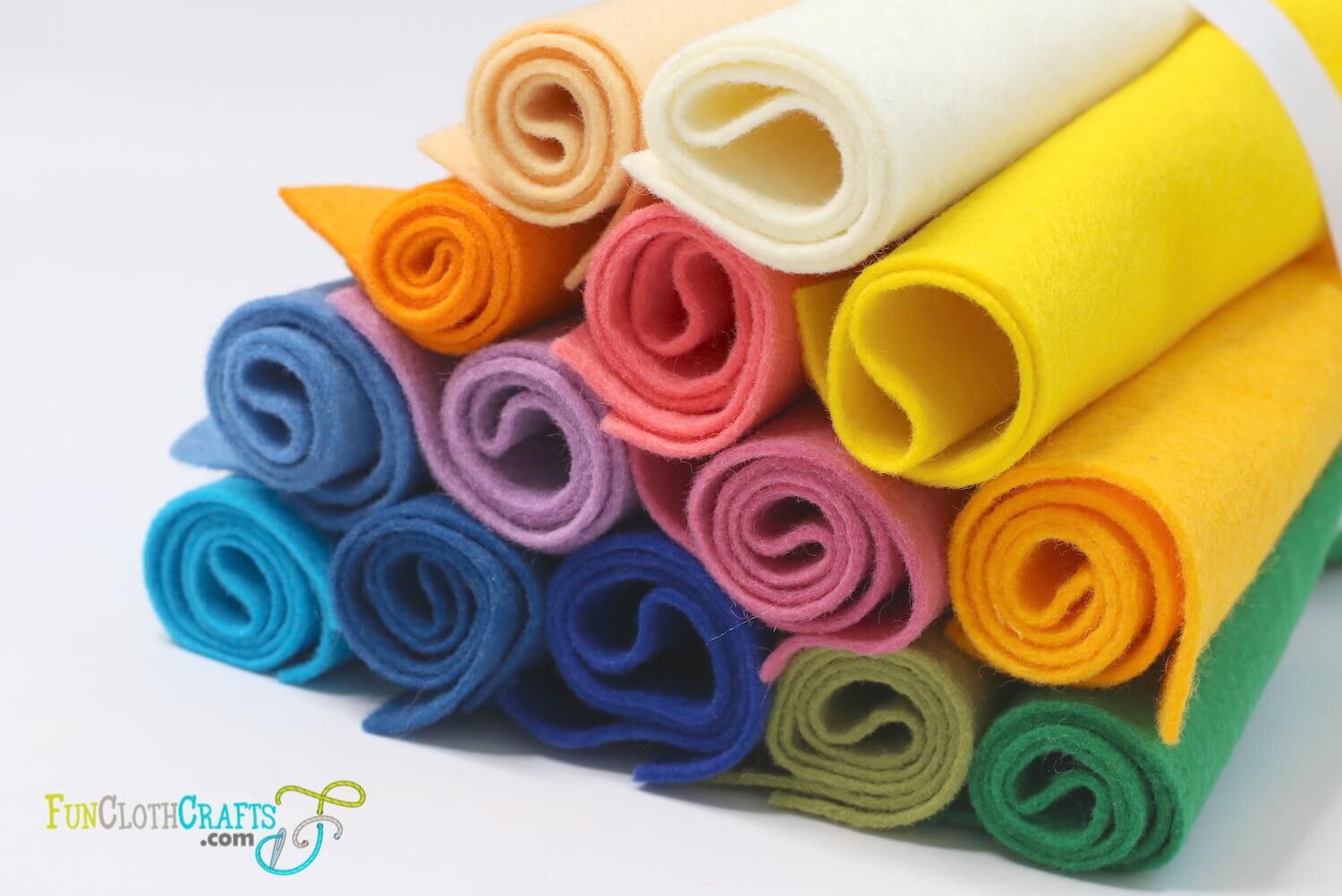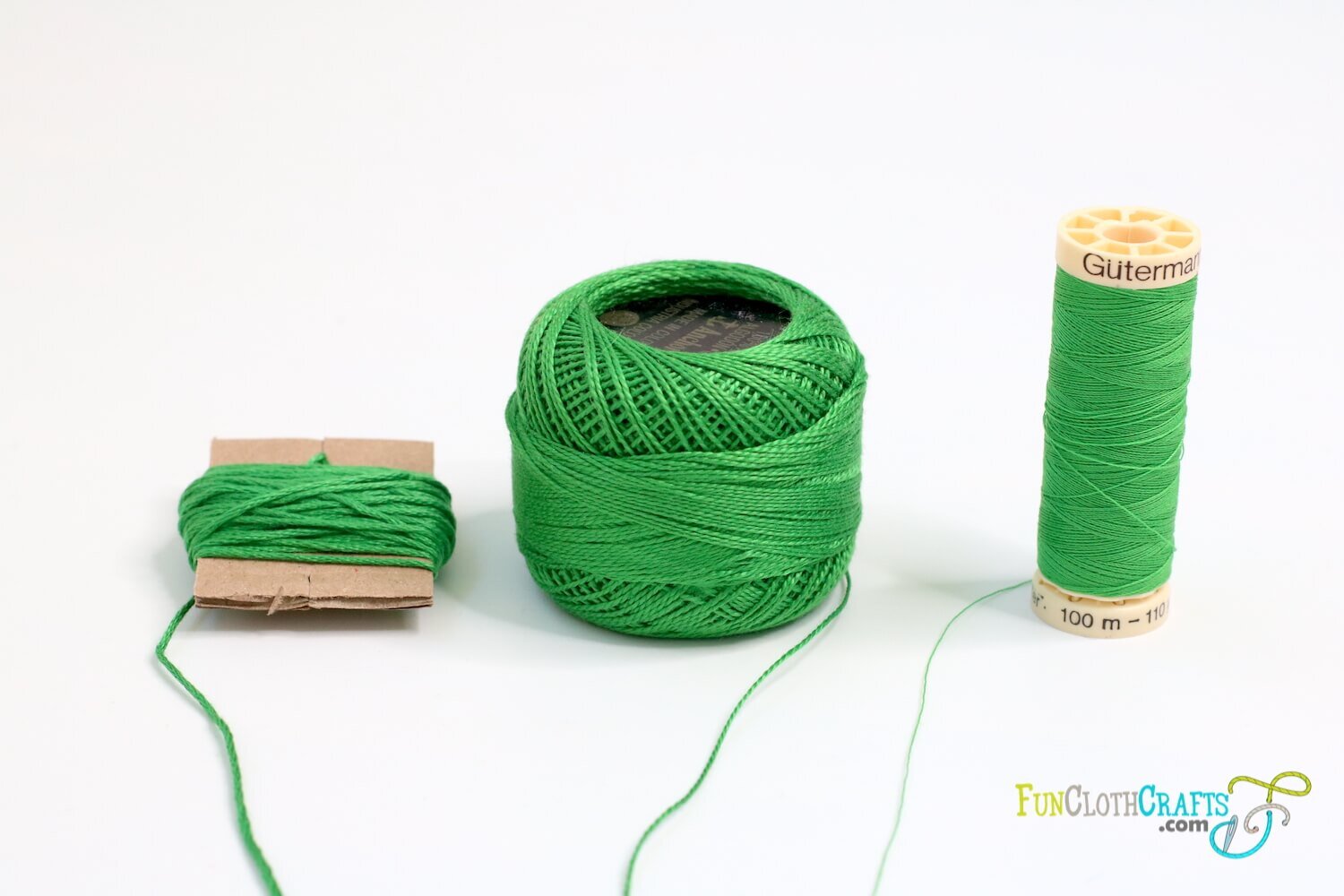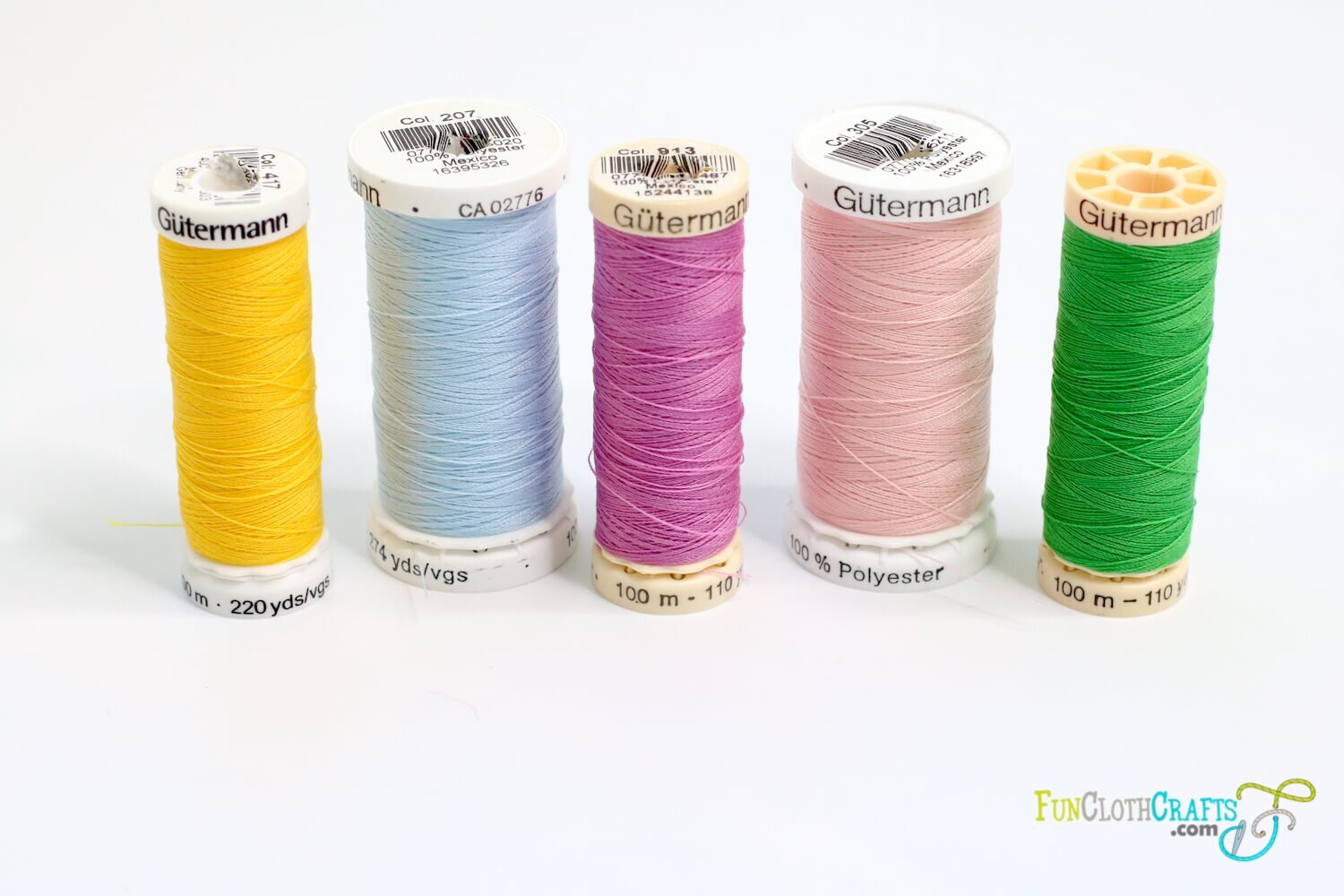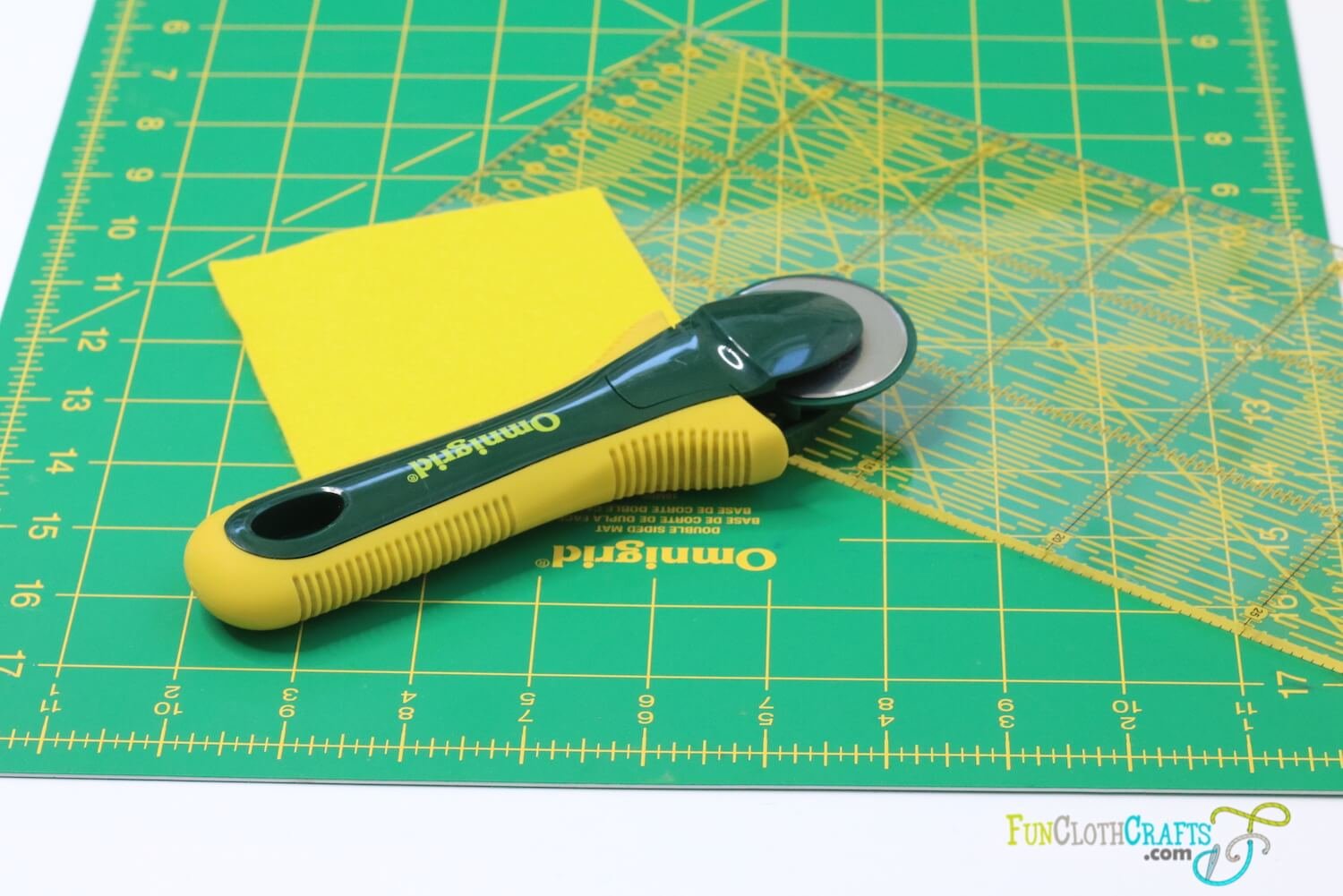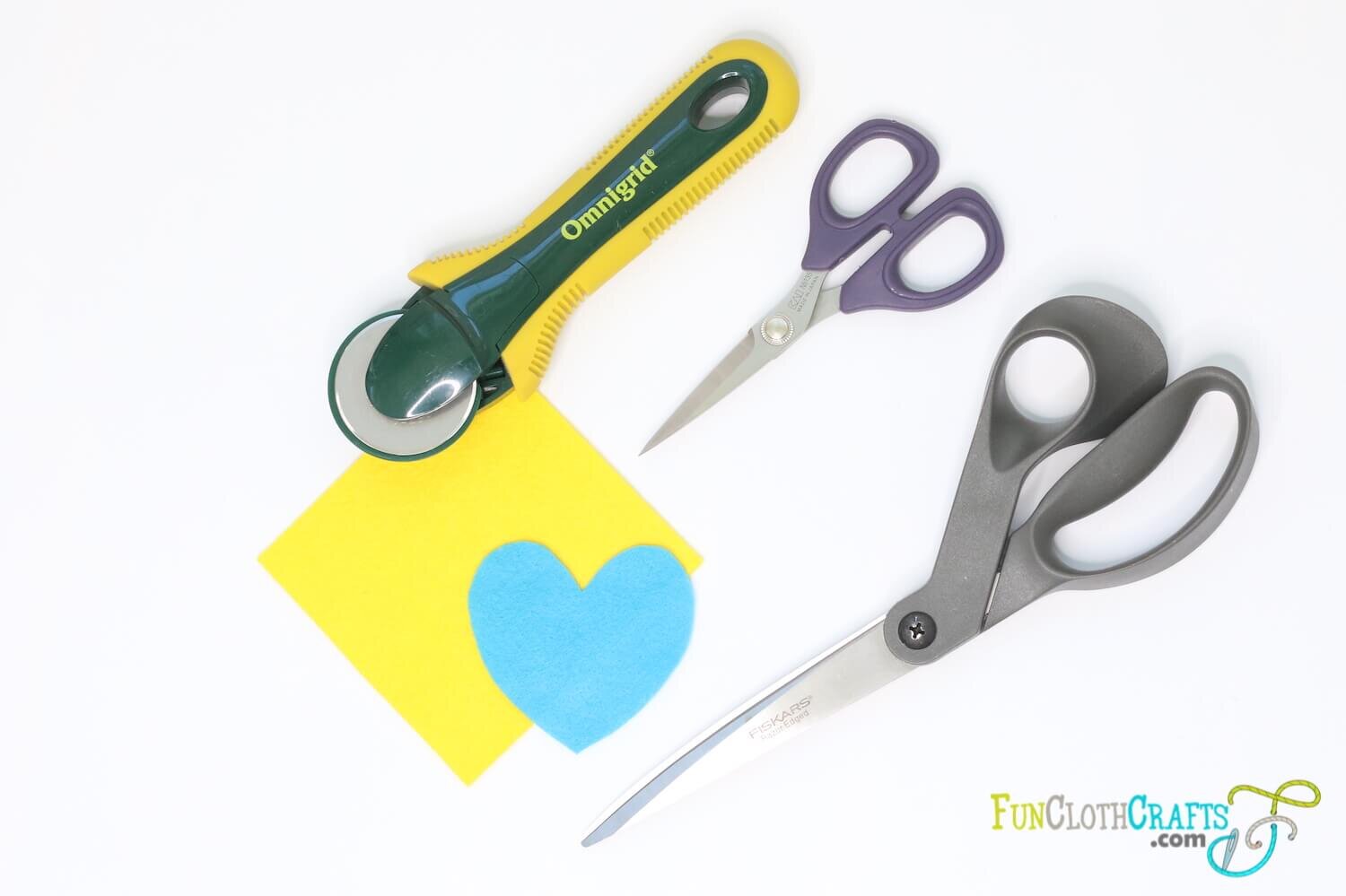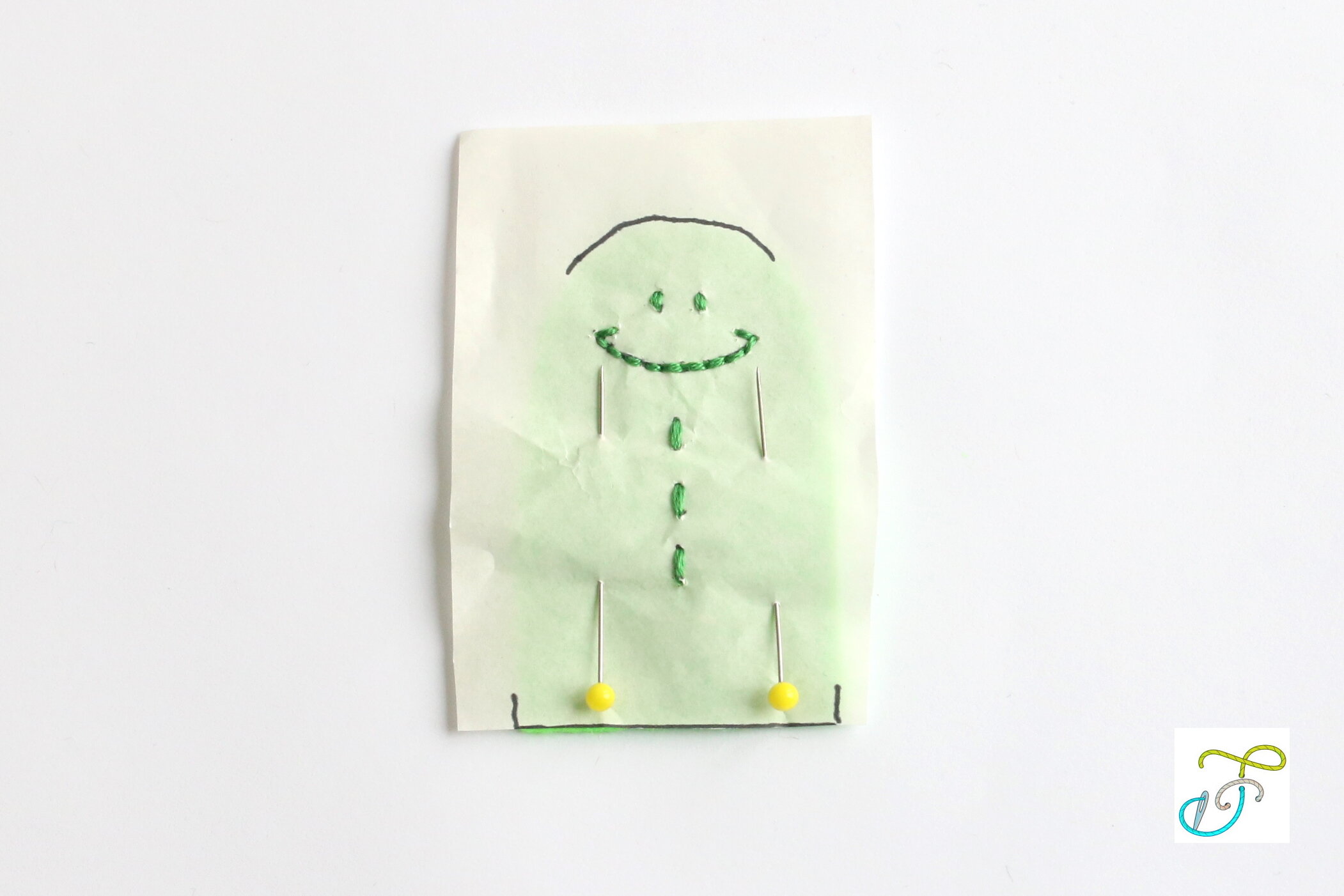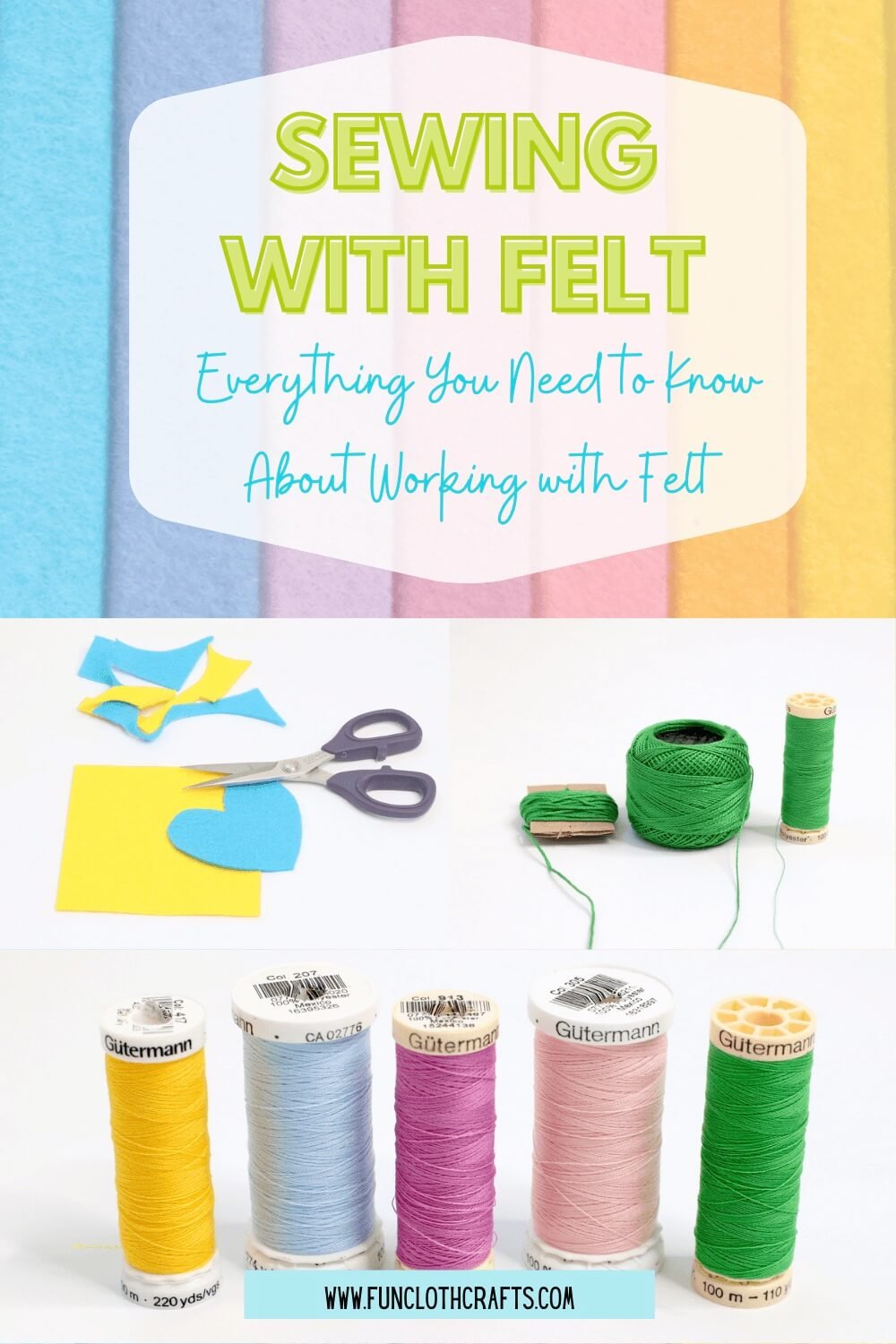How to Sew Felt: Tips for Felt Sewing Projects
This post contains affiliate links, which means I may earn a small commission at no additional cost to you if you click through the link and make a purchase. For more information, click here.
Felt is an excellent material for beginner’s sewing and is easy to use for kids’ craft projects. Their variety of colors and simple to sew structure make it a perfect material for many DIY projects; craft home decor, handmade gifts, or holiday decorations. Come and learn how to sew felt with these felt sewing tips.
These tips for sewing with felt aren’t only meant for sewing with felt for beginners, but for anybody who likes to learn new felt sewing tips and tricks. The guide provides a brief explanation of felt as material and felt types. Next, it suggests what thread and needles to use for crafting with felt. In the how to sections, you learn how to transfer, trace, and cut the felt shape. You’ll discover both hand sewing tips and machine sewing hacks for felt.
I hope this post will make it easier for you to craft your next beloved felt project.
Table of Content
1. What Is Felt Fabric?
Felt is a nonwoven fabric produced from fibers (the smallest visible unit of any textile) being matted, compressed, and often pressed together using heat and moisture. The result is a strong material consisting of permanently joined fibers.
Basic facts about felt:
Felt can be made of natural fibers such as wool or animal fur or from synthetic fibers. Blended fibers are standard as well. Eco-fi felt is made from 100% recycled plastic bottles.
Felt is resilient, waterproof, absorbent, and it is the best natural insulator.
Felt is used, for example, in musical instruments, fashion, home constructions, the automotive industry, and arts and crafts.
You can purchase felt in sheets or as a roll.
Wool blend felt
1. Advantages and Disadvantages of Felt
Advantages of Felt:
does not ravel or fray as woven fabrics
comes in many colors and thicknesses
easy to work with
inexpensive except for high-end felt
can be cut to any size, shape with a clean edge
can be sewed by hand as well as on a sewing machine
Disadvantages of Felt:
not easy to wash
minimal elasticity
potential for shrinking
can fuzz over time
felt from synthetic fibers may stretch out
2. Can You Make Felt at Home?
It is possible to make felt at home by wet felting. No special equipment is required to make felt at home using the wet felting process. Even complete beginners can produce great-looking results. For more on how to make felt at home, follow the tutorial Make you own felt.
2. Types of Felt
On the market, you can buy different types of felt. They primarily differ in the kind of fiber they are made of, which results in various quality of felt. Felt can be produced from synthetic fibers, natural fibers, or fiber blends.
Felt comes in various thicknesses ranging from 0.04 inch to 1 inch (1 mm to 25 mm). The preferred thickness for crafting with felt is about 0.05 to 0.06 inch (1,2 mm to 1,4 mm).
For felt crafts where you look for sturdiness, 1/8 inch felt (3 mm) can be used, for example, for Christmas stockings, coasters, placemats, bags, purses, slipper soles.
Felt also comes in different densities. The density is measured in g / m². Denser the felt is easier it is to work with it. Less dense felt may require interfacing so that the felt craft projects last.
How Can You Check the Quality of Felt Easily?
Using good-quality felt is important for better results with your felt craft project. How do you know if it’s of good quality? Do these simple tests:
If you hold the felt sheet up against the light and can easily see through it, chances are that you have low-quality felt at hand. It will be more difficult to cut this felt, and potentially it will fall apart as you sew the project (this felt is really, really low quality, but it can happen).
Take a small piece of felt and try to stretch it. If it stretches easily, it’s also low-quality felt.
Rub the felt with a finger for the last test to see how much it fuzzes. If you immediately get little balls on felt, it’s definitely not suitable for projects where the felt craft will be touched regularly.
1. Craft Felt
Craft felt is purely synthetic felt. It might pill and fuzz easily. Therefore it is not advised for sewing crafts where a long lifespan is needed, or a lot of handling is involved. It is the cheapest type of felt, which might make it a good option for kids' crafts or if your budget is too tight. The actual price depends on the synthetic fiber used, polyester being the most common in craft felt. It’s very typical to start your felt journey with craft felt and then move onto blended wool felt or wool felt. Synthetic felt offers some of the same benefits as conventional felt. However, unlike wool or fur, acrylic felt is highly flammable, and it is uncomfortable when worn against the skin.
Craft felt is not the most environmentally friendly option as the synthetics degrade very slowly and the manufacturing process creates chemical pollutants.
2. Korean Hard Felt
Korean hard felt is a stiffened polyester felt so also synthetic felt with the thickness of 0.05 inch (1 mm or 1,2 mm). As the name suggests, it is a felt that feels harder on touch, which makes it hold its shape better than craft felt. The edge of Korean hard felt does not crumble, does not stretch, and keeps the shape. Due to its stiffness, you can cut the edge easily with decorative scissors (pinking shears). It is trendy for creating Quiet Books. It is also used for kids’ crafts, charms, brooches, pendants, etc.
For the same reasons as craft felt, it is not the most environmentally friendly option.
It is more difficult to find than craft felt. Etsy is the best to go to if you like to purchase Korean hard felt. Visit Emilisa Kreativ (Germany), Blueberry Little Shop (UK) and Legacy Felt (US) on Etsy.
3. Eco-fi Felt
Eco-friendly felt known as Eco-fi, is a synthetic felt made from recycled plastic bottles. Its use can help to reduce plastic waste. This felt is perfect for children’s crafts and other projects that do not require the high-quality of wool felt. It’s not as soft to the touch and not as dense as wool-blend felt. It is a lovely alternative to craft felt for kids’ crafts. Kunin Felt produces Eco-fi felt in US. You can buy Eco-fi felt on Amazon.
4. Xotic Felt
Bamboo felt, known as Xotic felt, is a natural felt, made from 50% bamboo and 50% rayon fibers This eco-friendly felt is incredibly soft. It retains its shape through washing and doesn't shrink. The Xotic felt is a preferred option among vegans. You can buy Xotic felt here or on Etsy at TadaaStudioFelt (US) and Eco Friendly Crafts LLC (US).
5. Blended Wool Felt
Blended wool felt is a blend of nylon, polyester, polypropylene, or cotton material and wool. There are two common types of wool blends, the 20% wool/ 80% rayon blend or 35 % wool/ 65 % rayon blend, in-home crafting.
Blended wool felt is produced to provide some of the look and feel of wool felt, but at a lower price. When comparing polyester craft felt to blended wool felt, the blended felt will have a nice, nubby texture.
Rayon is a semi-synthetic fiber as it is produced from naturally occurring polymers. It is not, however, a natural fabric because cellulose requires extensive processing to become rayon.
Blended felt is more expensive than craft felt (about twice as much) but still reasonably priced.
Benzie Design (US) sells highly recommended wool blend felt. They also offer a wide variety of felt color palettes.
You can buy blended wool felt on Etsy at Gingermelon (Canada), The Felt Fairy (UK), Over The River Felt (US). You can buy blended wool felt on Amazon as well.
6. 100% Wool Felt
Wool felt is a natural material of high density and the best quality felt. This means that after the felt product has been used or become worn out, it can be safely disposed of as it is 100% biodegradable. The only potential environmental issues associated with these types of felt regard land use and proper animal stewardship. Wool felt has excellent wicking and durability abilities. When it comes to price, it is approximately two to three times more expensive than blended wool felt. In addition to being aesthetically pleasing, wool felt shares the beneficial attributes of its base fiber, including absorbency, fire resistance, and impressive insulative properties.
If you are looking to buy wool felt visit Atelier Anemoontje (The Netherlands) and Tintangel (The Netherlands) at Etsy.
In US, Benzie Design (US) offers Bellwether felt made of 100% pure merino wool which is made of exceptionally high quality fibers.
3. Thread for Sewing Felt
It’s handy to have a basic set of embroidery floss and polyester sewing threads at home. So that you don't have to run to a store every time you change felt color. For sewing felt together, I tend to coordinate my thread with felt color. If you can’t get a match, choose a thread color that is a shade darker than your felt. I also experimented with a contrasting shade to make the sewing stand out!
1. Thread for Sewing Felt by Hand
When sewing felt by hand, use strengthened polyester thread, perle cotton, or embroidery floss for a decorative look.
Embroidery floss is most commonly used for hand stitching felt, especially for felt appliqué. It's inexpensive and comes in a wide variety of colors. Embroidery floss is composed of 6 individual strands of thread twisted into one thick strand. I recommend separating it into 1, 2, or 3 strands from the bunch after cutting it to the desired length. But it’s a personal preference depending on your project. Thicker thread is used for tighter hold, visible stitching, or filling in details. Be aware that plush handmade toys, buttons, beads, and any small parts on toys made for children should not be sewn together with embroidery floss. They can be pulled apart much more easily than when sewed with polyester thread.
Embroidery floss is also available in silk, linen, glittered, metallic, and even glow in the dark! Variegated floss is a type of embroidery thread that gradually changes shade and even color while you are stitching because they are dyed with different color variations. When used carefully, variegated threads can create a lovely effect on an otherwise ordinary felt project.
Perle Cotton is a mercerized (treated to increase strength and add a bit of sheen), S-twisted, cotton embroidery thread. Perle cotton cannot be separated as compared to embroidery floss. It is extra soft and lustrous, thus the name, “Pearl.” Perle cotton comes in either a ball or skein and is available in different sizes (thicknesses). I like the look of Perle cotton thread but find it difficult to buy in a fabric and craft store.
For handmade toys edges, buttons, beads, and any small parts on toys made for children, you should opt polyester sewing threads - the exact same kind that you use for machine stitching. These threads are strong and reliable. They're ideal for reinforcement stitches around edges and plain stitches.
Thread for sewing with felt - embroidery floss, perle cotton, polyester sewing thread
2. Thread for Sewing Felt with Sewing Machine
For the sewing machine, I recommend an all-purpose polyester or cotton thread. You can use quilting thread too. For most felt projects you won’t need a special thread but can use ordinary sewing thread. Wool felt, or a predominantly wool blend should preferably be stitched using cotton sewing thread, while polyester, polyester-rich blends, and other synthetics should preferably be stitched using polyester thread.
Gütermann polyester thread
4. Needle for Sewing Felt
What needle to use when sewing with felt? I use an embroidery needle for embroidery floss and Perle cotton, a standard needle for sewing thread, and a medium-sized needle for working with felt on a sewing machine.
1. Needle for Sewing Felt by Hand
I use embroidery needles (also called crewel) when hand sewing and appliquéing with felt. Embroidery needles are similar to regular sewing needles, or sharps. They have a sharp tip but have a larger eye for thicker threads to fit through. Needle sizing is universal for all needles. Keep in mind that the smaller the number size, the larger the needle. So, a size 6 needle is larger than a size 10.
Choose the right sized needle. Opt for the smallest needle that will accommodate the thickness of your thread and that you are comfortable sewing with. Large needles can leave holes in you felt project.
For sewing felt with standard sewing thread by hand standard needle (also known as sharps) is a good choice.
Embroidery needles and standard needles
2. Needle for Sewing Felt with Sewing Machine
For sewing felt on a sewing machine, a medium-sized needle 70/10 or 80/12 will work well for regular felt. Thicker felt or more than two layers might require 90/14 needle. But be careful, a thicker needle may leave holes. With majority of felt sewing projects you’ll be fine with a medium-size needle.
For sewing felt, use a 70/10 or 80/12 universal machine needle.
5. How to Cut Out Felt
Once you’ve chosen your felt craft project, you’ll need to cut felt. Use smaller, sharp scissors with pointy ends (embroidery scissors) to get a neat finish and precise edges on your felt shapes. Buy good quality scissors, as felt tends to dull them. My tip for you is to use one pair of scissors only for felt projects (assuming you’ll do several of them). If you are in search of scissors for cutting felt, get all the knowledge in the best scissors to cut felt post.
For cutting felt squares, rectangles, or any straight lines, I prefer to use rotary cutter, a non-slip quilter's ruler, and a cutting mat. I would cut pages for Quiet books, puzzle base pieces, the felt crown base piece with the rotary cutter.
Tools for cutting felt - rotary cutter, a non-slip quilter’s ruler, cutting mat
It’s also handy to have a pair of larger scissors to cut the larger non-detailed pattern pieces. I used them to cut the felt letter banner shapes from 10 Mother’s Day Felt Craft Ideas for Kids.
Tools for cutting felt - rotary cutter, embroidery scissors, larger scissors
When cutting felt shapes from a pattern, there are several ways on how you can transfer the pattern and cut it out from felt. The most popular is to trace your template onto freezer paper with the matt side up. The shiny side of the paper will adhere to felt when ironed, making it easy to cut around the outline of your shape. You can then just peel the paper off. Learn 6 different ways on how to transfer templates to felt and cut the felt shape out in my post 6 Ways on How to Cut Out Felt.
You can also cut felt with electronic or manual cutting machines. Among the electronic cutting machines Brother Scan-N-Cut and Cricut Maker are highly recommended. Looking for help when deciding which die cutting machine is the best for felt? Find all the tips in the die cut machine for felt blog post. If you have your Cricut machine and need help cutting felt, read the Ultimate Guide to Cutting Felt with Cricut Machine.
For the manual cutting machines for felt, go for Sizzix Big Shot Plus. Together with the machine you purchase various dies (they come in all shapes and sizes). To cut the felt, you manually slide the felt and the die through the machine. It’s popular for cutting felt flower shapes. The cut felt shapes on manual cutting machines are limited to the dies available. Learn more about Sizzix Big Shot and tips on how to cut perfect felt shapes in Learn How to Cut Felt Using Sizzix.
6. How to Trace on Felt for Embroidery
How do you trace embroidery designs to felt? How do you add embroidery details to your felt projects? I use 3 different for tracing on felt for embroidery. My favorite one is using tracing paper. I draw the design on the tracing paper and then sew through it to transfer the design. For more information about the 3 different ways, visit the 4 Ways on How to Trace on Felt For Embroidery tutorial. As with all sewing techniques, practice makes it better. Be careful about your stitch size, length, and consistency. If I’m not happy with the final look of my stitching, I remove it and start over.
Using tracing paper for embroidery on felt
Embroidery on felt
7. How to Sew Felt
Learning how to sew felt is easy compared to other materials. Felt can be machine stitched or hand embroidered. It's a good material for beginners. As the edges of felt don’t fray, you can apply absolutely any stitch to join edges together, to appliqué or to even use quick, no-sew methods.
1. How to Sew Felt by Hand
Small projects, for instance, small stuffed animals, Christmas decorations, finger puppets, and the like, can easily be sewn by hand. It gives a more handmade look if you sew these types of projects by hand.
Needle and Thread for sewing felt by hand has already been described earlier in this post. Now let’s talk about the stitches. When sewing felt by hand, the running stitch, blanket stitch, and whip stitch are mostly used for sewing felt together (finishing off the edges). The blanket stitch also gives a decorative touch. For decorative purposes, the straight stitch, backstitch, and French knot are wonderful. They’re quick to master, French knot being the most challenging. Visit 9 Hand Embroidery Stitches for Felt to learn how to sew basic embroidery stitches.
2. Sewing Felt with Sewing Machine
Needle and Thread for felt sewing with a sewing machine has already been described earlier in this post. Now let’s talk about the stitches. I would always recommend that you do a test piece first on your machine to get the right tension and size of stitch. A straight stitch can be widely used for felt sewing. On some sewing machines you might find a blanket stitch. You can try it for stitching appliqué. It gives your felt project a nice handmade look.
The standard sewing foot should do well, when sewing most felt projects.
If sewing with thinner felt (craft felt), you might want to consider doubling the fabric up, or using a backing fabric to give it more stability, especially for shapes that are exposed to a lot of handling like a pocket in Quiet Books. 100% wool felt can usually support itself.
Tip on how to sew tiny curvy edges
Sew slowly, one stitch at a time. If needed sew with a handwheel. You can also stop with the needle in the fabric, lift the presser foot, turn the fabric as required, and lower the presser foot. The next tip might be helpful as well
Transport finger puppets sewed by a sewing machine
Tip for sewing two felt pieces together
The felt double-layer sewing trick is one of my tips on how to work with felt. In my experience, sewing two equal pieces of felt together may be challenging as they tend to move under the foot slightly. This technique is way easier. I have been happy to learn it from my friend and now pass it onto you.
Where could you use double-layer felt shape pieces?
To increase the durability of your creation
To hide sewing thread when attaching hooks, buttons,
When sewing puppets and finger puppets
When attaching velcro to one side of felt and more.
8. Washing and Ironing Your Felt Project
1. How to Wash Felt?
Note that I wouldn’t recommend washing felt in a machine washable. The fabric might shrink (more likely to happen for felt that includes wool), colors might bleed (threads for example), stuffing in felt plushies might not be washable. It must either be dry-cleaned or washed by hand. For washing by hand, apply cool water, soak the item in and gently squeeze the place, where the stain is. Don’t rub the stain on your felt craft as it might cause fuzzing and pilling.
Dry cleaning is a good option for cleaning the felt craft. You can remove surface dirt with a soft brush. Softly sweep felt in one direction. Spot cleaning with a little quantity of water is also possible if dry marks don’t brush off. Apply a damp cloth to gently dab away at them. Don’t rub the felt, or add soaps or cleaning products.
Leave the felt items to dry naturally in a flat position. Putting the item in the dryer will cause them to mat together thanks to the combination of heat and friction.
Watch the video from My Craft Quiet Books on how to hand wash felt toys, and removable parts of quiet books.
2. Can Felt Be Ironed?
Yes, you can iron felt. You just have to use the right technique for each type of felt. Set the right iron temperature (medium setting is good to start with) and have a dry dishtowel or cotton cloth on hand. Careful with acrylic and Eco-fi felt as the plastic might melt with higher temperatures. You can iron 100% wool felt with a wool heat setting. Cover the felt with a press cloth so you don’t damage the fibers or your iron. Learn more in the post 4 Great Tips That Prove You Can Iron Felt from the Sassy Packrat.
9. Free Felt Sewing Patterns
Find over 50 free felt craft patterns in my Freebies. Here is a selection of my free felt patterns:
10. Sewing Felt Conclusions
Now, you learnt new felt sewing tips to help you while sewing felt. You know what types of felt exist, what’s the best needle and thread for felt, how to trace on felt, and how to cut felt shapes. Explore the free patterns for felt and take you new skills to practice.
Thank you for reading! What are your thoughts? Let me know if you find this article useful and share any tips of yours!
Enjoy the crafting time :)
Feel free to join my mailing list! You’ll receive updates on new patterns, the latest sewing tips and tricks, and special promotions.
Let’s learn together!
XO, Anna


